Animal sacrifice
All or only part of a sacrificial animal may be offered; some cultures, like the ancient and modern Greeks, eat most of the edible parts of the sacrifice in a feast, and burnt the rest as an offering. Others burnt the whole animal offering, called a holocaust. Usually, the best animal or best share of the animal is the one presented for offering.
Animal sacrifice should generally be distinguished from the religiously prescribed methods of ritual slaughter of animals for normal consumption as food.
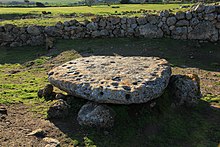
During the
Prehistory
By the end of the
Ancient Near East
Animal sacrifice was general among the
Ancient Greece
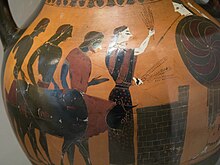
Worship in
The animals used are, in order of preference, bull or ox, cow, sheep (the most common), goat, pig (with piglet the cheapest mammal), and poultry (but rarely other birds or fish).

The evidence of the existence of such practices is clear in some ancient Greek literature, especially in Homer's epics. Throughout the poems, the use of the ritual is apparent at banquets where meat is served, in times of danger or before some important endeavor to gain the favor of the gods. For example, in Homer's Odyssey Eumaeus sacrifices a pig with prayer for his unrecognizable master Odysseus. However, in Homer's Iliad, which partly reflects very early Greek civilization, not every banquet of the princes begins with a sacrifice.[16]
These sacrificial practices, described in these pre-Homeric eras, share commonalities to the 8th century forms of sacrificial rituals. Furthermore, throughout the poem, special banquets are held whenever gods indicated their presence by some sign or success in war. Before setting out for Troy, this type of animal sacrifice is offered. Odysseus offers Zeus a sacrificial ram in vain. The occasions of sacrifice in Homer's epic poems may shed some light onto the view of the gods as members of society, rather than as external entities, indicating social ties. Sacrificial rituals played a major role in forming the relationship between humans and the divine.[17]
It has been suggested that the Chthonic deities, distinguished from Olympic deities by typically being offered the holocaust mode of sacrifice, where the offering is wholly burnt, may be remnants of the native Pre-Hellenic religion and that many of the Olympian deities may come from the Proto-Greeks who overran the southern part of the Balkan Peninsula in the late third millennium BCE.[18]
In the Hellenistic period after the death of Alexander the Great in 323 BCE, several new philosophical movements began to question the ethics of animal sacrifice.[19]
Scythians
According to the unique account by the Greek author Herodotus (c. 484 – c. 425 BCE), the Scythians sacrificed various kinds of livestock, though the most prestigious offering was considered to be the horse. The pig, on the other hand, was never offered in sacrifice, and apparently the Scythians were loath to keep swine within their lands.[20] Herodotus describes the Scythian manner of sacrifice as follows:
The victim stands with its fore-feet tied, and the sacrificing priest stands behind the victim, and by pulling the end of the cord he throws the beast down; and as the victim falls, he calls upon the god to whom he is sacrificing, and then at once throws a noose round its neck, and putting a small stick into it he turns it round and so strangles the animal, without either lighting a fire or making any first offering from the victim or pouring any libation over it: and when he has strangled it and flayed off the skin, he proceeds to boil it. [...] Then when the flesh is boiled, the sacrificer takes a first offering of the flesh and of the vital organs and casts it in front of him.[21]
Herodotus goes on to describe the human sacrifice of prisoners, conducted in a different manner.
Ancient Rome

The most potent offering in

Sacrifice to deities of the heavens (di superi, "gods above") was performed in daylight, and under the public gaze. Deities of the upper heavens required white, infertile victims of their own sex:
A sacrifice might be made in thanksgiving or as an
a piaculum might also be offered as a sort of advance payment; the Arval Brethren, for instance, offered a piaculum before entering their sacred grove with an iron implement, which was forbidden, as well as after.[26] The pig was a common victim for a piaculum.[27]
The same divine agencies who caused disease or harm also had the power to avert it, and so might be placated in advance. Divine consideration might be sought to avoid the inconvenient delays of a journey, or encounters with banditry, piracy and shipwreck, with due gratitude to be rendered on safe arrival or return. In times of great crisis, the Senate could decree collective public rites, in which Rome's citizens, including women and children, moved in procession from one temple to the next, supplicating the gods.[28]
Extraordinary circumstances called for extraordinary sacrifice: in one of the many crises of the Second Punic War, Jupiter Capitolinus was promised every animal born that spring (see ver sacrum), to be rendered after five more years of protection from Hannibal and his allies.[29] The "contract" with Jupiter is exceptionally detailed. All due care would be taken of the animals. If any died or were stolen before the scheduled sacrifice, they would count as already sacrificed, since they had already been consecrated. Normally, if the gods failed to keep their side of the bargain, the offered sacrifice would be withheld. In the imperial period, sacrifice was withheld following Trajan's death because the gods had not kept the Emperor safe for the stipulated period.[30] In Pompeii, the Genius of the living emperor was offered a bull: presumably a standard practise in Imperial cult, though minor offerings (incense and wine) were also made.[31]
The exta were the entrails of a sacrificed animal, comprising in
Celtic peoples
There is evidence that ancient Celtic people sacrificed animals, almost always livestock or working animals, as part of ancient Celtic religion.[34] The idea seems to have been that ritually transferring a life-force to the Otherworld pleased the gods and established a channel of communication between the worlds. Animal sacrifices could be acts of thanksgiving, appeasement, to ask for good health and fertility, or as a means of divination. It seems that some animals were offered wholly to the gods (by burying or burning), while some were shared between gods and humans (part eaten and part set aside).[34]
Archaeologists have found evidence of animal sacrifice at some Gaulish and British sanctuaries,[35] and at the Irish site Uisneach.[36] Accounts of Celtic animal sacrifice come from Roman and Greek writers. Julius Caesar and Strabo wrote of the Gauls burning animal sacrifices in a large wickerwork figure, known as a wicker man,[37] while Pliny the Elder wrote of druids performing a 'ritual of oak and mistletoe' which involved sacrificing two white bulls.[38]
Some animal sacrifice or ritual slaughter continued among Celtic peoples long after they converted to Christianity. Until the 19th century, on
Germanic peoples
Animal sacrifice, or blót, was an important ritual in Old Norse religion. The blood was sprinkled on altars, idols and the walls of temples. A blót was made at seasonal festivals as well as at funerals, before battles and perilous journeys, or after the conclusion of business between traders.[42]
In the 11th century, Adam of Bremen wrote that human and animal sacrifices were made at the Temple at Gamla Uppsala in Sweden. He wrote that every ninth year, nine men and nine of every animal were sacrificed and their bodies hung in a sacred grove.[43]
Abrahamic traditions
Judaism
In Judaism, the qorban is any of a variety of sacrificial offerings described and commanded in the Torah. The most common usages are animal sacrifice (zevah זֶבַח), zevah shelamim (the peace offering) and olah (the "holocaust" or burnt offering). A qorban was an animal sacrifice, such as a bull, sheep, goat, or a dove that underwent shechita (Jewish ritual slaughter). Sacrifices could also consist of grain, meal, wine, or incense.[44][45]
The Hebrew Bible says that Yahweh commanded the Israelites to offer offerings and sacrifices on various altars. The sacrifices were only to be offered by the hands of the Kohanim. Before building the Temple in Jerusalem, when the Israelites were in the desert, sacrifices were offered only in the Tabernacle. After building Solomon's Temple, sacrifices were allowed only there. After the Temple was destroyed, sacrifices was resumed when the Second Temple was built until it was also destroyed in 70 CE. After the destruction of the Second Temple sacrifices were prohibited because there was no longer a Temple, the only place allowed by halakha for sacrifices. Offering of sacrifices was briefly reinstated during the Jewish–Roman wars of the second century CE and was continued in certain communities thereafter.[46][44][47]
The
Christianity


A handful of rural Christian communities sacrifice animals (which are then consumed in a feast) as part of worship, especially at
Islam
Muslims engaged in the Hajj (pilgrimage) are obliged to sacrifice a lamb or a goat or join others in sacrificing a cow or a camel during the celebration of the Eid al-Adha,[52][53] an Arabic term that means "Feast of Sacrifice", also known as al-Id al-Kabir (Great Feast), or Qurban Bayrami (Sacrifice Feast) in Turkic influenced cultures, Bakar Id (Goat Feast) in Indian subcontinent and Reraya Qurben in Indonesia.[54] Other Muslims not on the Hajj to Mecca also participate in this sacrifice wherever they are, on the 10th day of the 12th lunar month in the Islamic calendar.[54] It is understood as a symbolic re-enactment of Abraham's sacrifice of a ram in place of his son. Meat from this occasion is divided into three parts, one part is kept by the sacrificing family for food, the other gifted to friends and family, and the third given to the poor Muslims. The sacrificed animal is a sheep, goat, cow or camel. The feast follows a communal prayer at a mosque or open air.[54][55]

The animal sacrifice during the Hajj is a part of nine step pilgrimage ritual. It is, states Campo, preceded by a statement to intention and body purification, inaugural circumambulation of the Kaaba seven times, running between Marwa and Safa hills, encampment at Mina, standing in Arafat, stoning the three Mina satanic pillars with at least forty nine pebbles. Thereafter, animal sacrifice, and this is followed by farewell circumambulation of the Kaaba.[56][57] The Muslims who are not on Hajj also perform a simplified ritual animal sacrifice. According to Campo, the animal sacrifice at the annual Islamic festival has origins in western Arabia in vogue before Islam.[56] The animal sacrifice, states Philip Stewart, is not required by the Quran, but is based on interpretations of other Islamic texts.[58]
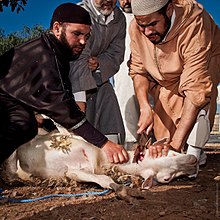
The Eid al-Adha is major annual festival of animal sacrifice in Islam. In Indonesia alone, for example, some 800,000 animals were sacrificed in 2014 by its Muslims on the festival, but the number can be a bit lower or higher depending on the economic conditions.[59] According to Lesley Hazleton, in Turkey about 2,500,000 sheep, cows and goats are sacrificed each year to observe the Islamic festival of animal sacrifice, with a part of the sacrificed animal given to the needy who did not sacrifice an animal.[60] According to The Independent, nearly 10,000,000 animals are sacrificed in Pakistan every year on Eid.[61][62] Countries such as Saudi Arabia transport nearly a million animals every year for sacrifice to Mina (near Mecca). The sacrificed animals at Id al-Adha, states Clarke Brooke, include the four species considered lawful for the Hajj sacrifice: sheep, goats, camels and cattle, and additionally, cow-like animals initialing the water buffalo, domesticated banteng and yaks. Many are brought in from north Africa and parts of Asia.[63]
Other occasions when Muslims perform animal sacrifice include the 'aqiqa, when a child is seven days old, is shaved and given a name. It is believed that the animal sacrifice binds the child to Islam and offers protection to the child from evil.[57]
Killing of animals by dhabihah is ritual slaughter rather than sacrifice.[citation needed]
Hinduism
Practices of
Shaktism traditions

Animal sacrifices are performed mainly at temples following the Shakti school of Hinduism where the female nature of Brahman is worshipped in the form of Kali and Durga. These traditions are followed in parts of eastern states of India at Hindu temples in Assam and West Bengal India and Nepal where goats, chickens and sometimes water buffalos are sacrificed.
Animal sacrifice is a part of Durga puja celebrations during the Navratri in eastern states of India. The goddess is offered sacrificial animal in this ritual in the belief that it stimulates her violent vengeance against the buffalo demon.[69] According to Christopher Fuller, the animal sacrifice practice is rare among Hindus during Navratri, or at other times, outside the Shaktism tradition found in the eastern Indian states of West Bengal, Odisha[70] and Assam. Further, even in these states, the festival season is one where significant animal sacrifices are observed.[69] In some Shakta Hindu communities, the slaying of buffalo demon and victory of Durga is observed with a symbolic sacrifice instead of animal sacrifice.[71][72][note 1]
Animal sacrifice en masse occurs during the three-day-long Gadhimai festival in Nepal. In 2009 it was speculated that more than 250,000 animals were killed[75] while 5 million devotees attended the festival.[76] However, this practise was later banned in 2015.[77][78][79]
Rajput traditions
The Rajput of Rajasthan worship their weapons and horses on Navratri, and formerly offered a sacrifice of a goat to a goddess revered as Kuldevi – a practice that continues in some places.[80][81] The ritual requires slaying of the animal with a single stroke. In the past this ritual was considered a rite of passage into manhood and readiness as a warrior.[82] The Kuldevi among these Rajput communities is a warrior-pativrata guardian goddess, with local legends tracing reverence for her during Rajput-Muslim wars.[83]
The tradition of animal sacrifice is being substituted with vegetarian offerings to the Goddess in temples and households around
Folk traditions
In some sacred groves of India, particularly in western Maharashtra, animal sacrifice is practiced to pacify female deities that are supposed to rule the groves.[85]
In India, ritual of animal sacrifice is practised in many villages before local deities or certain powerful and terrifying forms of the Devi. In this form of worship, animals, usually goats, are decapitated and the blood is offered to deity often by smearing some of it on a post outside the temple.[86] For instance, Kandhen Budhi is the reigning deity of Kantamal in Boudh district of Orissa, India. Every year, animals like goat and fowl are sacrificed before the deity on the occasion of her annual Yatra/Jatra (festival) held in the month of Aswina (September–October). The main attraction of Kandhen Budhi Yatra is Ghusuri Puja. Ghusuri means a child pig, which is sacrificed to the goddess every three years. Kandhen Budhi is also worshipped at Lather village under Mohangiri GP in Kalahandi district of Orissa, India.[87] (Pasayat, 2009:20–24).[full citation needed]
The religious belief of Tabuh Rah, a form of animal sacrifice of Balinese Hinduism includes a religious cockfight where a rooster is used in religious custom by allowing him to fight against another rooster in a religious and spiritual cockfight, a spiritual appeasement exercise of Tabuh Rah.[88] The spilling of blood is necessary as purification to appease the evil spirits, and ritual fights follow an ancient and complex ritual as set out in the sacred lontar manuscripts.[89]
Tantrik traditions
Human sacrifice is also mentioned in Hinduism in the Kalika Purana.[90] Chapters 67 through 78 of the text constitute the Rudhiradhyaya, which discusses bali (animal sacrifice) and of Vamacara Tantrism. The Rudhiradhyaya section is notable for its uncommon discussion of human sacrifice. The text states that a human sacrifice may be performed to please the goddess, but only with the consent of prince before a war or cases of imminent danger.[citation needed] However, it was not until 2014 that the National Crime Records Bureau (NCRB) started collecting data on human sacrifice. According to the bureau, there were 51 cases of human sacrifice spread across 14 states between 2014 and 2016.[90] An alleged case of human sacrifice was recorded as late as 2020.[91]
East Asian traditions
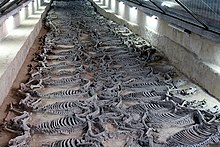
Han Chinese
Ancient China
During
The ancient kings, Confucius and Confucian scholars framed the sacrificing scale of every strata from the Zhou system, not including human sacrifice, in The Book of Rites. The names of the offering scales from honorable to low are 'Tai-lao'(太牢), 'Shao-lao'(少牢), 'Te-sheng'(特牲), 'Te-shi'(特豕), 'Te-tun'(特豚), 'Yu'(魚), 'La'(臘), 'Dou'(豆) and else. The Tai-lao class, now only practiced in the ceremony of worshipping Huang Di or Confucius, use whole cows, whole goats and whole pigs in Taiwan
[93]
It is said Hou ji offered a sacrifice with lamb millet and southern wood and black millet whine with fragrant herbs mainly southern wood.
Modern-day China
Buddhism prohibits all forms of killing, rituals, sacrifices and worship and Taoism generally prohibit killing of animals.[94][95][96] In Kaohsiung, Taiwan, animal sacrifices are banned in Taoist temples.[97]
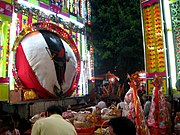

Some animal offerings, such as fowl, pigs, goats, fish, or other livestock, are accepted in some Taoism sects and beliefs in
Japan
Before Buddhism came to Japan, some Shinto festivals included bear, deer, horse, and green pheasant sacrifice. [citation needed] Iomante (イオマンテ), sometimes written as Iyomante (イヨマンテ), is an Ainu ceremony in which a brown bear is sacrificed.
Traditional Sub-Saharan and Afro-American religions
Animal sacrifice is regularly practiced in
The
Austronesian
Utux
Atayal, Seediq and Taroko people believe that bad-luck or punishments of 'Utux', which refers to any kind of supernatural spirits or ancestors, would infect the relatives. When a member in relatives has violated a taboo or met with misfortune, a ritual will be held. It must be done in the ritual to sacrifice a pig, which means the misfortune and sin would be washed away by the blood, and apologize to the Utux with gift.[104]
See also
- Animal welfare
- Animal worship
- Anthrozoology
- Bans on ritual slaughter
- Folk religion
- Human sacrifice
- Religious abuse
- Self-flagellation
- Self-mutilation
- Slaughter offering
Notes
- ^ In these cases, Shaktism devotees consider animal sacrifice distasteful, practice alternate means of expressing devotion while respecting the views of others in their tradition.[73] A statue of asura demon made of flour, or equivalent, is immolated and smeared with vermilion to remember the blood that had necessarily been spilled during the war.[71][72] Other substitutes include a vegetal or sweet dish considered equivalent to the animal.[74]
References
- ISBN 0-520-05875-5.)
{{cite book}}: CS1 maint: others (link - ^ "Egyptian Religion and the Problem of the Category "Sacrifice"". academic.oup.com. Retrieved 2022-12-06.
- ^ a b Flores, Diane Victoria (2003). Funerary Sacrifice of Animals in the Egyptian Predynastic Period (PDF).
- ^ "In Ancient Egypt, Life Wasn't Easy for Elite Pets". National Geographic. 2015. Archived from the original on May 29, 2015.
- ^ Herodotus, Histories 2.38, 2.39,2.40,2.41,2.42
- ^ Archaeological Institute of America (2016). "Ancient Canaanites Imported Animals from Egypt".
- ISBN 1-84217-113-5.
- ^ C.Michael Hogan, Knossos Fieldnotes, The Modern Antiquarian (2007) Archived April 16, 2016, at the Wayback Machine
- ^ "New funerary and ritual behaviors of the Neolithic Iberian populations discovered". EurekAlert!. 25 September 2020.
- ^ a b Burkert (1972), pp. 8–9, google books
- ^ Burkert (1985), 2:1:1, 2:1:2. For more exotic local forms of sacrifice, see the Laphria (festival), Xanthika, and Lykaia. The advantageous division of the animal was supposed to go back to Prometheus's trick on Zeus]]
- ^ Burkert (1985): 2:1:1; to some extent different animals were thought appropriate for different deities, from bulls for Zeus and Poseidon to doves for Aphrodite, Burkert (1985): 2:1:4
- ^ Burkert (1985): 2:1:2
- ^ Burkert (1985): 2:1:4
- ^ Sarah Hitch, King of Sacrifice: Ritual and Royal Authority in the Iliad, online at Archived 2021-01-25 at the Wayback Machine Harvard University's Center for Hellenic Studies
- ^ Meuli, Karl (1946). Griechische Opferbräuche. Schwabe.
- ISBN 978-0-521-29037-1.
- ^ Burkert (1972), 6–7
- ^ Macaulay (1904:315).[full citation needed]
- ^ Macaulay (1904:314).
- ^ Halm, in Rüpke (ed), 239.
- ^ a b Scheid, in Rüpke (ed), 263–71.
- ^ Though the household Lares do just that, and at least some Romans understood them to be ancestral spirits. Sacrifices to the spirits of deceased mortals are discussed below in Funerals and the afterlife.
- ^ Jörg Rüpke, Religion of the Romans (Polity Press, 2007, originally published in German 2001), p. 81 online.
- ^ William Warde Fowler, The Religious Experience of the Roman People (London, 1922), p. 191.
- Robert E.A. Palmer, "The Deconstruction of Mommsen on Festus 462/464 L, or the Hazards of Interpretation", in Imperium sine fine: T. Robert S. Broughton and the Roman Republic (Franz Steiner, 1996), p. 99, note 129 online; Roger D. Woodard, Indo-European Sacred Space: Vedic and Roman Cult (University of Illinois Press, 2006), p. 122 online. The Augustan historian Livy (8.9.1–11) says [[Publius Decius Mus (consul 340 BCE|P. Decius Mus]] is "like" a piaculum when he makes his vow to sacrifice himself in battle (devotio).
- ISBN 9781444341317.
- ^ Beard et al., Vol 1, 32–36.
- ^ Gradel, 21: but this need not imply sacrifice as a mutual contract, breached in this instance. Evidently the gods had the greater power and freedom of choice in the matter. See Beard, et al., 34: "The gods would accept as sufficient exactly what they were offered – no more, no less." Human error in the previous annual vows and sacrifice remains a possibility.
- ^ Gradel, 78, 93
- ^ Cicero, De divinatione 2.12.29. According to Pliny (Natural History 11.186), before 274 BCE the heart was not included among the exta.
- ^ Robert Schilling, "The Roman Religion", in Historia Religionum: Religions of the Past (Brill, 1969), vol. 1, pp. 471–72, and "Roman Sacrifice," Roman and European Mythologies (University of Chicago Press, 1992), p. 79; John Scheid, An Introduction to Roman Religion (Indiana University Press, 2003, originally published in French 1998), p. 84.
- ^ a b Green, Miranda (2002). Animals in Celtic Life and Myth. Routledge. pp. 94–96.
- ^ Green, pp.109-110
- ^ Schot, Roseanne (2006). "Uisneach Midi a medón Érenn: a prehistoric cult centre and royal site in Co. Westmeath". Journal of Irish Archaeology, issue 15. pp.39-46
- ^ Davidson, Hilda Ellis (1988). Myths and Symbols in Pagan Europe: Early Scandinavian and Celtic Religions. Syracuse University Press. pp. 60–61.
- ^ Koch, John (2006). Celtic Culture: A Historical Encyclopedia. ABC-CLIO. p. 612.
- ^ MacCulloch, John Arnott (1911). The Religion of the Ancient Celts. Chapter 18: Festivals.
- ^ Hutton, Ronald. The Stations of the Sun: A History of the Ritual Year in Britain. Oxford University Press, 1996. p.386
- ^ MacNeill, Máire. The Festival of Lughnasa: A Study of the Survival of the Celtic Festival of the Beginning of Harvest. Oxford University Press, 1962. pp.407, 410
- ISBN 978-1-84217-444-9.
- ^ Davidson, Hilda Ellis (1988). Myths and Symbols in Pagan Europe: Early Scandinavian and Celtic Religions. Syracuse University Press. p. 59.
- ^ a b Zotti, Ed, ed. (17 April 2003). "Why do Jews no longer sacrifice animals?". The Straight Dope.
- ^ Rabbi Zalman Kravitz. "Jews For Judaism". Archived from the original on 2016-03-30. Retrieved 2016-04-24.
- ^ "Judaism 101: Qorbanot: Sacrifices and Offerings".
- ^ "What is the Tabernacle of Moses?". Archived from the original on 2016-04-27. Retrieved 2016-04-24.
- ^ Barton 1903, p. 9.
- ^ a b Kovaltchuk (2008), p. 163.
- ^ Kovaltchuk (2008), pp. 162–63.
- ^ "Maya and Catholic Religious Syncretism at Chamula, Mexico". Vagabondjourney.com. 2011-11-26. Retrieved 2014-02-12.
- ISBN 978-1576070895.
- ^ Bongmba, Elias Kifon. The Wiley-Blackwell Companion to African Religions. Wiley.com. p. 327.
- ^ ISBN 978-1-4381-2696-8.
- .
- ^ ISBN 978-1-4381-2696-8.
- ^ ISBN 978-1-135-17967-0.
- ^ Philip J. Stewart (1979), Islamic law as a factor in grazing management: The Pilgrimage Sacrifice, The Commonwealth Forestry Review, Vol. 58, No. 1 (175) (March 1979), pp. 27–31
- ^ Animal Sacrifice in the World’s Largest Muslim-Majority Nation, The Wall Street Journal (September 23, 2015)
- ISBN 978-1-59691-799-6.
- ^ Eid al-Adha 2016: When is it and why does it not fall on the same date every year?, Harriet Agerholm, The Independent (6 September 2016)
- PMID 21330071.
- ., Quote: "Id al-Adha's lawful sacrificial offerings include the four species prescribed for Hajj sacrifice, sheep, goats, camels and cattle, and additionally, cow-like animals initialing the water buffalo, domesticated banteng and yaks. To meet market demands for sacrificial animals, pastoralists in northern Africa and southwestern Asia increased their flocks and overstocked grazing land, consequently accelerating the deterioration of biotic resources."
- ISBN 978-0774807241.
- ISBN 978-1590562819.
- ISBN 9004141251.
- ISBN 978-0742550551.
- ISBN 0-691-12048-X.
- ^ ISBN 0-691-12048-X.
- ^ Hardenberg, Roland (2000). "Visnu's Sleep, Mahisa's Attack, Durga's Victory: Concepts of Royalty in a Sacrificial Drama" (PDF). Journal of Social Science. 4 (4): 267. Retrieved 29 September 2015.
- ^ a b Hillary Rodrigues 2003, pp. 277–78.
- ^ a b June McDaniel 2004, pp. 204–05.
- ISBN 978-1-139-49317-8.
- ISBN 978-0-231-12919-0.
- ^ Olivia Lang in Bariyapur (2009-11-24). "Hindu sacrifice of 250,000 animals begins". The Guardian. London. Retrieved 2012-08-13.
- ^ "Ritual animal slaughter begins in Nepal". CNN. 2009-11-24. Retrieved 2012-08-13.
- ^ Ram Chandra, Shah. "Gadhimai Temple Trust Chairman, Mr Ram Chandra Shah, on the decision to stop holding animal sacrifices during the Gadhimai festival. Later the trust denied the decision, as per trust such decision was obtained forcefully by animal right. Trust said it is not in our hand to stop the sacrifice it is up to people, as trust or priest never ask devotee to offer sacrifice. It is their sole and self decision " (PDF). Humane Society International. Retrieved 29 July 2015.
- Vice Media, Inc.Retrieved 29 July 2015.
- ^ Kumar Yadav, Praveen; Tripathi, Ritesh (29 July 2015). "Gadhimai Trust dismisses reports on animal sacrifice ban". Archived from the original on 27 June 2018. Retrieved 26 August 2018.
- ISBN 978-0195154269. Retrieved 14 October 2016.
- ISBN 978-0814736197.
- ISBN 0-520-07339-8.
- ISBN 0-520-07339-8.
- ISBN 07914-5399-5. Retrieved 26 October 2015.
- ^ Gadgil, M; VD Vartak (1975). "Sacred Groves of India" (PDF). Journal of the Bombay Natural History. 72 (2): 314.
- ISBN 978-0823931798.
- ^ "Archived copy" (PDF). Archived (PDF) from the original on 2012-03-18. Retrieved 2015-02-18.
{{cite web}}: CS1 maint: archived copy as title (link) - ISBN 9789799101150.
- ISBN 1900949512.
- ^ a b Bhattacharya, Aritra (6 November 2018). "Does Goddess Kali Really Demand Human Sacrifice to Slay Demons?". The Quint. Retrieved 24 May 2021.
- ^ Rajaram, R (3 June 2020). "Murder gets human sacrifice colour". The Hindu. Pudukottai: Kasturi & Sons. Retrieved 24 May 2021.
- ^ Herbert Plutschow (1996). "Archaic Chinese Sacrificial Practices in the Light of Generative Anthropology". Anthropoetics. Retrieved 2021-07-22.
As we have learned above, Shang dynasty sacrifice consisted in humans and animals and, to a lesser extent, wine and food (millet), and sometimes, as practiced later in Japan, tools, weapons and clothing. Sacrificial animals included dogs (traditionally interpreted as guides for the spirits, to help them during their hunts), and also sheep, oxen and pigs.
- ^ "祭孔的起源與發展" (in Chinese). Taipei Confucius Temple Governing Board. Retrieved 2021-07-19.
...高祖十二年(前195年)十二月,漢高祖劉邦平定英布之亂後,於返京途中,路過曲阜孔廟,漢高祖以全牛、全豬、全羊之太牢重禮祭孔廟,為後世立下天子祭孔典範。
- ^ 办丧事或祭祀祖先可以杀生吗 Archived March 31, 2012, at the Wayback Machine
- ^ 齋醮略談 Archived March 6, 2016, at the Wayback Machine
- ^ 符籙齋醮 Archived April 22, 2010, at the Wayback Machine
- ^ "中山大學 West BBS-西子灣站 / 分類佈告 / maev91 / 高雄地名知多少". Archived from the original on 2011-08-12. Retrieved 2011-08-28.
- ^ "林真-馬年運程, 馬年運氣書,風水、掌相、看相、八字、命理、算命".
- ^ 衣紙2 Archived March 13, 2012, at the Wayback Machine
- ^ 道教拜神用品 Archived July 5, 2007, at the Wayback Machine
- ISBN 978-1584321774.
- ^ Insoll, T. Talensi Animal Sacrifice and its Archaeological Implications, pp. 231–34
- ^ " Archived October 22, 2016, at the Wayback Machine. Full text of the opinion courtesy of Findlaw.com.
- ^ "太魯閣族" (in Chinese). 原住民族委員會. Retrieved 2021-07-22.
在部落中有一種力量,就如泰雅的gaga一樣,太魯閣叫做gaya。Gaya是家與部落的中心,每一個成員都必須嚴格遵守的,否則一人違規全家或全部落都會遭殃的。 這種力量像是一種規訓,如果不遵守就會觸犯禁忌、受到祖先的懲罰,這時必須殺豬來解除。其內容各gaya間會略有不同,但大抵來說都是道德上的訓誡,如不可口出穢言、要參與部落活動等等。
Bibliography
- Hillary Rodrigues (2003). Ritual Worship of the Great Goddess: The Liturgy of the Durga Puja with Interpretations. SUNY Press. ISBN 978-0-7914-8844-7.
- June McDaniel (2004). Offering Flowers, Feeding Skulls: Popular Goddess Worship in West Bengal. Oxford University Press. ISBN 978-0-19-534713-5.
- Barik, Sarmistha (2009), "Bali Yatra of Sonepur" in Orissa Review, Vol.LXVI, No.2, September, pp. 160–62.
- Burkert, Walter (1972), Homo Necans pp. 6–22
- ISBN 0674362810
- Gihus, Ingvild Saelid. Animals, Gods, and Humans: Changing Ideas to Animals in Greek, Roman, and early Christian Ideas. London; New York: Routeledge, 2006.*Pasayat, C. (2003), Glimpses of Tribal an Folkculture, New Delhi: Anmol Publications Pvt. Ltd., pp. 67–84.
- Insoll, T. 2010. Talensi Animal Sacrifice and its Archaeological Implications. World Archaeology 42: 231–44
- Garnsey, Peter. Food and Society in Classical Antiquity. Cambridge: Cambridge University Press, 1999.
- Kovaltchuk, Ekaterina (2008). "The Encaenia of St Sophia: Animal Sacrifice in a Christian Context". Scrinium. 4 (1): 158–200. S2CID 191410592.
- Pasayat, C. (2009), "Kandhen Budhi" in Orissa Review, Vol.LXVI, No.2, September, pp. 20–24.
- Petropoulou, M.-Z. (2008), Animal Sacrifice in Ancient Greek Religion, Judaism, and Christianity, 100 BC to AD 200, Oxford classical monographs, Oxford University Press, ISBN 978-0-19-921854-7.
- Rosivach, Vincent J. The System of Public Sacrifice in Fourth-Century Athens. Atlanta, GA: Scholars Press, 1994.
